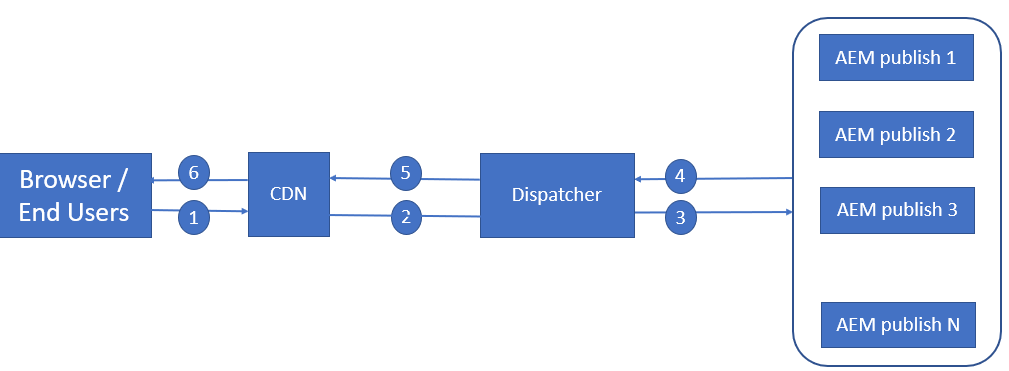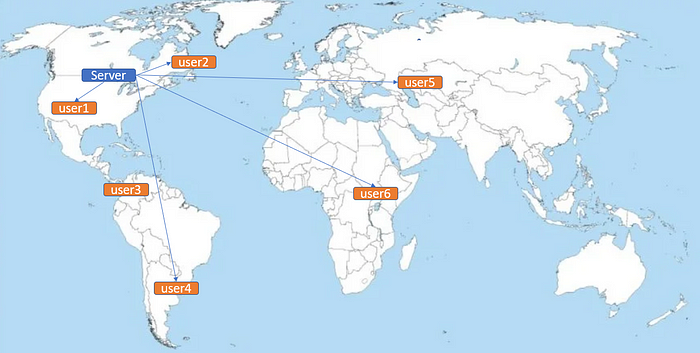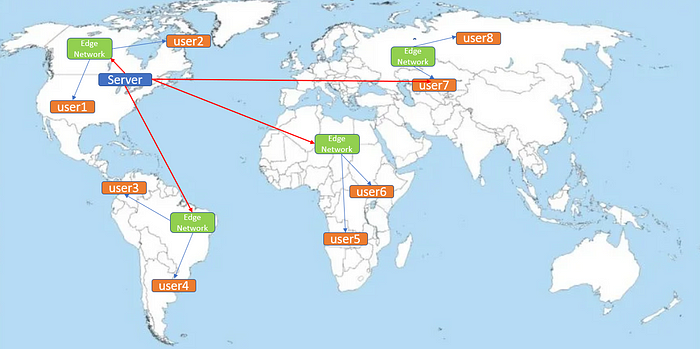Javadoubts

AEM CDN & SSL
This tutorial will help us to understand how code server, dispatcher, CDN, and SSL work together.
CDN offers us the ability to significantly improve the performance of our web applications by enabling the ultra-fast delivery of content and assets to end users. At the same time, it aids in enhancing the security of our site by providing SSL encryption.
Overall Flow
Below is the overall content and asset flow:
- As shown in below inline diagram, end user or any third-party service hit site URL.
- On first place request will reach out to CDN. CDN will return required data if found in cache.
- Request will reach out to dispatcher if required response not found on CDN. Dispatcher will return required data if found in cache.
- Dispatcher will look for required data in one of the AEM publish instance which can also be called as renderers if not found in dispatcher cache.

Why do we need CDN?
Let’s consider a scenario where our server is handling multiple requests and providing responses to a diverse range of end users. In this context, there are several crucial factors to understand:
The server’s response time can vary for users accessing the server from different locations around the world. This variation is primarily due to the distance between the server and the user. The greater the distance, the longer it may take for the server to respond.

Additionally, high traffic volumes can strain the server, potentially leading to slower response times or, in extreme cases, server downtime.
CDN addresses these issues by distributing our web content across its global network of servers. When a user accesses our site, CND serves the content from the nearest server in its network, thereby reducing latency and improving load times. This not only enhances the user experience but also alleviates the load on our primary server.
A Content Distribution Network (CDN) assists us in resolving the aforementioned issue by efficiently fetching data in a shorter amount of time through the utilization of Edge Networks. The Edge network functions by delivering static content and assets to nearby end users, which are stored as part of a cache.
When a user sends a request to retrieve data, the request is initially validated on the Edge network. If the data is found, the response is promptly returned. In the event that the data is not found on the Edge network, the request proceeds to the origin server, highlighted in blue. Upon obtaining the response from the origin server, the CDN caches the static content in a nearby location before returning the response to the user.
Subsequent requests to the same URL will benefit from the cached data stored in the nearby edge server, resulting in faster response times and an overall improved user experience.

SSL (Secure Sockets Layer)
SSL provides us security with the help data encryption flowing over the internet. No one can know what data is flowing over the internet as it is a sequence of characters.
Websites having HTTPS as part of their URL allow to implement SSL.
SSL (Secure Sockets Layer) plays a crucial role in securing online communications. It initiates an authentication process known as a handshake between two communicating devices. This process is designed to ensure that both devices are indeed who they claim to be, thereby establishing a secure connection.
What Are the Types of SSL Certificates?
SSL certificates come in various types, each catering to different needs. Depending on the type, one certificate can secure a single website or multiple websites. Here’s a closer look at these types:
Single-Domain SSL Certificate:
A single-domain SSL certificate is specific to one domain (the website’s name, such as www.javadoubts.com). This type of certificate does not extend its security to any other domain or subdomain.
Wildcard SSL Certificate:
Similar to the single-domain certificate in its application to one primary domain, the wildcard SSL certificate goes a step further. It covers not only the main domain but also all of its subdomains. For instance, if you have a wildcard certificate for www.javadoubts.com, it will also secure blog.javadoubts.com and developers.javadoubts.com. In contrast, a single-domain certificate would only secure www.javadoubts.com.
Multi-Domain SSL Certificate:
The multi-domain SSL certificate is designed for broader coverage. It can secure multiple unrelated domains under one certificate. This type is particularly useful for businesses managing a portfolio of different websites, allowing them to streamline their SSL management.
Each type of SSL certificate offers a different level of coverage, making it important to choose the one that best fits your website’s security needs.

Imran Khan
Specialist Master (Architect) with a passion for cutting-edge technologies like AEM (Adobe Experience Manager) and a proven track record of delivering high-quality software solutions.
- Languages: Java, Python
- Frameworks: J2EE, Spring, Struts 2.0, Hibernate
- Web Technologies: React, HTML, CSS
- Analytics: Adobe Analytics
- Tools & Technologies: IntelliJ, JIRA
📝 Blogs
javadoubts.com © All rights reserved